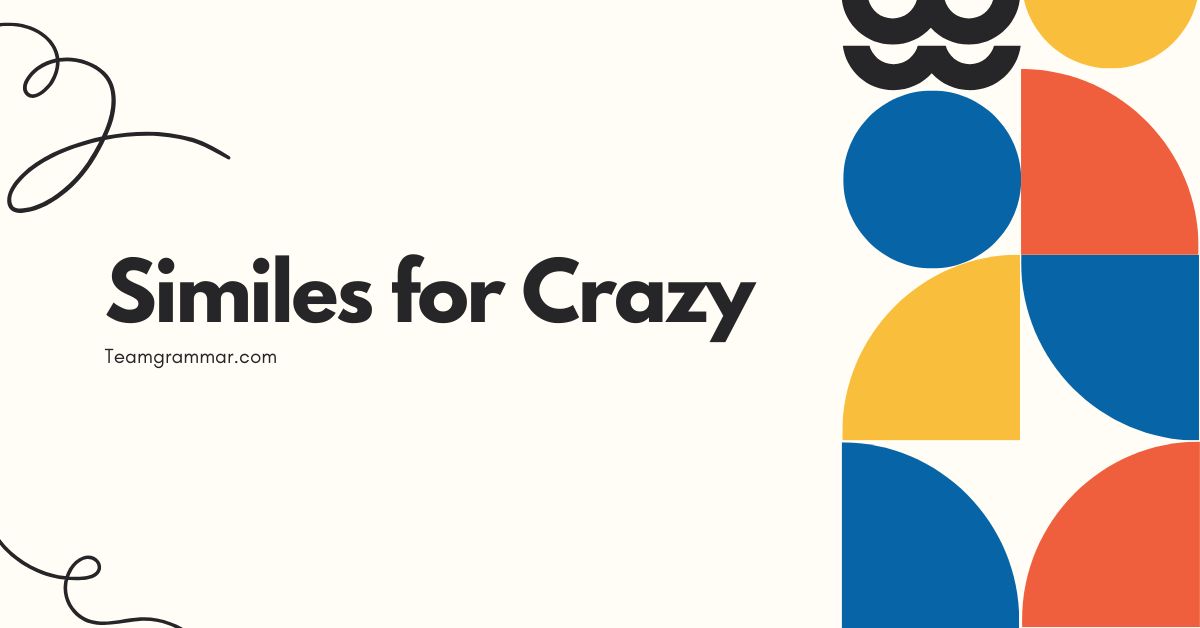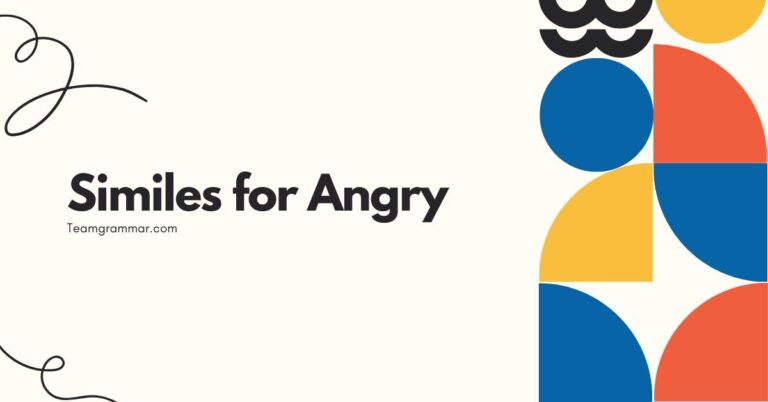44 Similes for Crazy: Mastering Figurative Language
Understanding similes is crucial for enriching your English vocabulary and enhancing your writing. Similes, a type of figurative language, allow you to make vivid comparisons and create more engaging and descriptive sentences.
This article focuses specifically on similes used to describe “crazy,” providing you with a wide range of options to express this concept in creative and nuanced ways. Whether you’re an English language learner, a student studying literature, or simply someone who wants to improve their writing skills, this guide will provide you with the knowledge and practice you need to master similes for “crazy.”
Table of Contents
- Introduction
- Definition of a Simile
- Structural Breakdown of Similes
- Types of Similes
- Examples of Similes for “Crazy”
- Usage Rules for Similes
- Common Mistakes with Similes
- Practice Exercises
- Advanced Topics: Nuances and Context
- Frequently Asked Questions (FAQ)
- Conclusion
Definition of a Simile
A simile is a figure of speech that directly compares two different things using the words “like” or “as.” The purpose of a simile is to create a vivid image or emphasize a particular quality of one thing by associating it with something else that is more familiar or easily understood. Similes are a powerful tool for writers and speakers to add color, depth, and emotion to their language.
Similes fall under the broader category offigurative language, which includes metaphors, personification, and hyperbole. Unlike a metaphor, which states that one thing *is* another, a simile only suggests a resemblance.
This indirect comparison allows for greater flexibility and subtlety in expression. For example, instead of saying “He is a tornado,” which is a metaphor, you might say “He islikea tornado,” which is a simile.
The function of a simile is to enhance understanding and create a more engaging experience for the reader or listener. By drawing a comparison to something familiar, similes can make abstract concepts more concrete and relatable.
In the context of describing someone as “crazy,” similes can help convey the intensity, unpredictability, or irrationality of their behavior in a more impactful way.
Structural Breakdown of Similes
The basic structure of a simile consists of three key elements: the subject, the linking word (“like” or “as”), and the object of comparison. The subject is the thing being described, the linking word establishes the comparison, and the object of comparison is the thing to which the subject is being compared.
Let’s break down the structure with an example: “He was as mad as a hatter.”
- Subject: He (the person being described)
- Linking Word: as
- Object of Comparison: a hatter (historically known for using mercury in hat-making, which led to neurological damage and perceived madness)
The phrase “as mad as a hatter” implies that the person’s behavior is similar to the erratic or irrational behavior associated with hatters of the past. The simile highlights the intensity and perhaps the unpredictability of the person’s madness.
Another example: “She acted like a woman possessed.”
- Subject: She (the person being described)
- Linking Word: like
- Object of Comparison: a woman possessed (implying a loss of control and irrational behavior)
Understanding this structural framework allows you to create your own similes and analyze the effectiveness of similes used by others. By carefully selecting the object of comparison, you can fine-tune the specific nuance you want to convey about the subject.
Types of Similes
While all similes share the same basic structure, they can be categorized based on the type of comparison they make. Understanding these categories can help you choose the most effective simile for a particular situation.
Descriptive Similes
Descriptive similes focus on highlighting a specific attribute or characteristic of the subject. These similes often use sensory language to create a vivid image.
For example, “He was as pale as a ghost” emphasizes the person’s lack of color, creating a visual impression of fear or illness.
Explanatory Similes
Explanatory similes aim to clarify or explain something by comparing it to something more familiar. These similes can be particularly useful for making abstract concepts more understandable.
For example, “His mind was like a tangled web” helps to convey the complexity and confusion of his thoughts.
Emphatic Similes
Emphatic similes are used to emphasize the intensity or degree of a particular quality. These similes often involve exaggeration or hyperbole to create a stronger impact.
For example, “He was as crazy as a loon” is a more forceful way of saying that someone is acting strangely.
Examples of Similes for “Crazy”
Here are several examples of similes used to describe “crazy,” categorized for clarity.
General Similes
These similes provide a general sense of madness or irrationality.
The following table contains a variety of general similes that describe someone as “crazy.” These similes use different objects of comparison to highlight various aspects of irrationality or madness, from being completely out of control to simply being eccentric.
| Simile | Explanation |
|---|---|
| As crazy as a loon | Loons are known for their erratic behavior and haunting calls. |
| As mad as a hatter | Hatters historically suffered from mercury poisoning, leading to erratic behavior. |
| Like a cat on a hot tin roof | Describes someone restless, agitated, and unable to settle down. |
| As nutty as a fruitcake | Suggests someone is eccentric or slightly odd. |
| Like a headless chicken | Describes someone running around in a panicked and disorganized manner. |
| As daft as a brush | Implies someone is foolish or silly. |
| Like a bat out of hell | Describes someone behaving wildly and uncontrollably. |
| As bonkers as a bag of frogs | A playful way of saying someone is completely crazy. |
| Like a squirrel on meth | Modern simile depicting hyperactive and erratic behavior. |
| As mad as a March hare | March hares are known for their frenzied behavior during mating season. |
| Like a dog chasing its tail | Suggests someone is engaged in a pointless and repetitive activity. |
| As gaga as a goose | Implies someone is silly or foolish. |
| Like a bull in a china shop | Describes someone clumsy and destructive, lacking control. |
| As unhinged as a screen door in a hurricane | Highlights a state of being unstable and out of control. |
| Like a wheel come off its axle | Suggests a loss of control and stability. |
| As off the rails as a runaway train | Implies a complete loss of control and direction. |
| Like a broken record | Describes someone repeating the same crazy thing over and over. |
| As wound up as a top ready to spin off the table | Implies someone who is highly agitated and about to lose control. |
| Like trying to herd cats | Suggests a chaotic and uncontrollable situation. |
| As screwy as a three-dollar bill | Implies something is fake, odd, and not quite right. |
| Like a fruit loop | A modern, playful way of describing someone as crazy. |
| As loopy as a rollercoaster | Suggests wild ups and downs and unpredictable behavior. |
| Like a chicken with its head cut off | Describes someone acting frantically and without direction. |
| As batty as an old belfry | Implies someone is eccentric or slightly mad. |
| Like a frog in a blender | A more extreme simile depicting chaotic and destructive behavior. |
Animalistic Similes
These similes compare the subject’s behavior to that of animals known for their wild or unpredictable actions.
The following table contains similes that compare a person’s “crazy” behavior to that of animals. These similes leverage the inherent characteristics associated with certain animals, such as wildness, unpredictability, or irrationality, to vividly describe the person’s state.
| Simile | Explanation |
|---|---|
| Like a caged tiger | Suggests someone is restless, agitated, and desperate to break free. |
| As wild as a banshee | Banshees are mythical creatures known for their terrifying screams and wails. |
| Like a rabid dog | Implies someone is aggressive, dangerous, and out of control. |
| As mad as a hornet | Hornets are known for their aggressive stinging behavior when provoked. |
| Like a monkey throwing its own poo | Suggests someone behaving in a childish, disruptive, and disgusting manner. |
| Like a cornered rat | Implies someone is desperate and will act unpredictably to escape. |
| As skittish as a cat in a thunderstorm | Describes someone is easily frightened and prone to panic. |
| Like a wild mustang | Suggests someone is untamed, free-spirited, and difficult to control. |
| As jumpy as a frog on a hotplate | Implies someone is extremely nervous and reactive. |
| Like a hyena on laughing gas | Describes someone with a disturbing and uncontrolled laughter. |
| As feral as a wolf | Suggests someone is untamed, savage, and lives by their own rules. |
| Like a swarm of bees | Implies chaotic and unpredictable behavior |
| As unpredictable as a rattlesnake | Describes someone whose actions cannot be anticipated. |
| Like a peacock on crack | Modern simile depicting erratic and flamboyant behavior. |
| As loony as a tune | A playful simile suggesting someone is silly and nonsensical. |
| Like a fish out of water | Describes someone who is out of place and uncomfortable. |
| As stubborn as a mule | Implies someone is unwilling to change their mind or behavior, even when irrational. |
| Like a moth to a flame | Suggests someone is irresistibly drawn to something dangerous or self-destructive. |
| As slippery as an eel | Implies someone is evasive and difficult to catch or understand. |
| Like a gazelle in headlights | Describes someone paralyzed by fear or confusion. |
Object-Based Similes
These similes compare the subject’s state to inanimate objects that are broken, malfunctioning, or out of control.
The following table contains similes that use inanimate objects to describe “crazy” behavior. These similes often focus on the idea of something being broken, malfunctioning, or unstable, reflecting the disarray and lack of control associated with madness.
| Simile | Explanation |
|---|---|
| Like a broken record | Suggests someone is repeating the same thing over and over again, obsessively. |
| As unhinged as a door | Implies someone is unstable, erratic, and prone to sudden outbursts. |
| Like a loose cannon | Describes someone unpredictable and dangerous, acting without restraint. |
| As wired as a bomb | Suggests someone is tense, anxious, and about to explode with anger or frustration. |
| Like a runaway train | Implies someone is out of control and unstoppable. |
| As twisted as a pretzel | Describes someone with a distorted or confused mind. |
| Like a shattered mirror | Suggests someone is fragmented, broken, and unable to see themselves clearly. |
| As volatile as nitroglycerin | Implies someone is highly unstable and prone to sudden, violent reactions. |
| Like a skipping CD | Describes someone who is repeating themselves or getting stuck on a particular thought. |
| As glitchy as a broken computer | Suggests someone is malfunctioning or behaving erratically. |
| Like a broken compass | Implies someone has lost their sense of direction or purpose. |
| As corroded as old metal | Describes mental decline or decay. |
| Like a tangled ball of yarn | Suggests a confused, complicated, and difficult-to-unravel mind. |
| As warped as a vinyl record left in the sun | Implies that someone’s mind is distorted and unreliable. |
| Like a deflated balloon | Describes someone who has lost their energy and enthusiasm. |
| As rusty as an unused tool | Suggests someone’s mental abilities have deteriorated due to lack of use. |
| Like a house of cards | Implies someone is fragile and easily broken. |
| As erratic as a faulty heart monitor | Describes someone with unpredictable and irregular behavior. |
| Like a broken telephone | Suggests someone is misunderstanding or misinterpreting information. |
| As hollow as a drum | Implies someone lacks substance or depth. |
Abstract Similes
These similes use abstract concepts or ideas to describe the subject’s mental state.
The following table contains similes that use abstract concepts to describe “crazy” behavior. These similes often focus on the intangible aspects of madness, such as chaos, confusion, or loss of control, providing a deeper and more nuanced understanding of the person’s state.
| Simile | Explanation |
|---|---|
| Like a storm brewing | Suggests someone is building up to an emotional outburst. |
| As unpredictable as chaos theory | Implies someone’s behavior is inherently random and impossible to predict. |
| Like a dream gone sour | Suggests someone is experiencing a distorted or nightmarish reality. |
| As lost as a soul in purgatory | Implies someone is confused, disoriented, and unable to find their way. |
| Like a ship without a rudder | Suggests someone has lost their sense of direction and purpose. |
| As empty as a void | Implies someone lacks emotions, thoughts, or meaning. |
| Like a shadow in the night | Suggests someone is hidden, elusive, and difficult to understand. |
| As turbulent as a stormy sea | Describes someone with intense and unpredictable emotions. |
| Like a puzzle with missing pieces | Implies someone is incomplete, fragmented, and unable to function properly. |
| As fragile as a house of cards | Suggests someone is easily broken or overwhelmed. |
| Like a flame flickering in the wind | Implies someone is unstable and easily extinguished. |
| As dark as the abyss | Describes someone with a deeply troubled or disturbed mind. |
| Like a ghost from the past | Suggests someone is haunted by memories or regrets. |
| As ethereal as a dream | Describes someone who is detached from reality. |
| Like a broken promise | Implies someone is unreliable and untrustworthy. |
| As haunting as a melody from a forgotten song | Suggests someone is troubled by memories or emotions. |
| Like a echo in a cave | Implies someone is repeating something without understanding. |
| As fleeting as a shooting star | Describes someone who is unpredictable and short-lived. |
| Like a maze with no exit | Suggests someone is trapped in their own mind. |
| As elusive as a mirage | Implies someone is difficult to grasp or understand. |
Hyperbolic Similes
These similes use exaggeration to emphasize the extent of the subject’s craziness.
The following table contains hyperbolic similes to describe someone as “crazy.” These similes use exaggeration to emphasize the extremity of the person’s behavior, highlighting the intensity and absurdity of their actions.
| Simile | Explanation |
|---|---|
| As crazy as a sack full of hammers | Emphasizes the extreme and chaotic nature of the person’s madness. |
| Like a tornado in a trailer park | Suggests someone is causing widespread chaos and destruction. |
| As mad as a meat axe | Implies someone is extremely angry and dangerous. |
| Like a one-man demolition derby | Describes someone who is recklessly destructive. |
| As loony as a left-handed monkey wrench | A nonsensical simile emphasizing the absurdity of the person’s behavior. |
| Like a rocket scientist on bath salts | Modern simile implying someone is behaving irrationally and unpredictably. |
| As nutty as squirrel turds | A vulgar simile emphasizing the person’s extreme craziness. |
| Like a clown at a funeral | Suggests someone is behaving inappropriately and insensitively. |
| As weird as a unicorn riding a narwhal | A bizarre simile emphasizing the person’s strangeness. |
| Like a screen door in a submarine | Suggests someone is completely out of place and useless. |
| As off as a herd of turtles on a skateboard | A humorous simile emphasizing the person’s awkwardness and lack of coordination. |
| Like a penguin in the Sahara | Suggests someone is completely out of their element. |
| As useful as an ashtray on a motorcycle | Implies someone is completely useless and unnecessary. |
| Like a fish wearing socks | A nonsensical simile emphasizing the person’s absurdity. |
| As sane as a bag of rabid weasels | Emphasizes the complete lack of sanity. |
| Like a politician telling the truth | Suggests something is highly improbable or impossible. |
| As common as a nun at a strip club | Suggests something is completely out of place. |
| Like arguing with a brick wall | Implies someone is completely unresponsive and unwilling to listen. |
| As likely as pigs flying | Suggests something is impossible. |
| Like finding a needle in a haystack | Implies something is extremely difficult or impossible to find. |
Usage Rules for Similes
While similes are a creative tool, there are a few guidelines to keep in mind for effective use.
- Clarity: The comparison should be clear and easily understood. Avoid obscure or overly complex references.
- Relevance: The object of comparison should have a logical connection to the subject being described. The comparison should highlight a relevant quality or characteristic.
- Originality: While some similes are commonly used, strive for originality to make your writing more engaging and memorable. Avoid clichés.
- Context: The appropriateness of a simile depends on the context. Consider the tone and audience of your writing when choosing a simile.
For example, instead of saying “He was as crazy as… something nobody’s ever heard of,” choose an object of comparison that is more widely recognized. Ensure that the comparison actually makes sense.
If you say, “He was as crazy as a calm sea,” the simile doesn’t effectively convey the idea of craziness because a calm sea is the opposite of chaotic.
Common Mistakes with Similes
Several common mistakes can weaken the impact of similes.
Using clichés: Overused similes like “as busy as a bee” can make your writing sound unoriginal.
Incorrect: He was as crazy as a loon. (This is acceptable but overused)
Correct: He was like a frog in a blender.
Mixing metaphors and similes: Avoid combining a simile with a metaphor in the same phrase.
Incorrect: He was a crazy tornado, like a destructive force.
Correct: He was like a tornado, a destructive force.
Unclear comparisons: Make sure the comparison is logical and easily understood.
Incorrect: He was as crazy as a doorknob. (The connection is unclear)
Correct: He was as crazy as a headless chicken running around a farmyard.
Redundant comparisons: Avoid stating the obvious.
Incorrect: He was as crazy as someone who is insane.
Correct: He was as crazy as a mad scientist.
Practice Exercises
Test your understanding of similes with these exercises.
Exercise 1: Fill in the Blanks
Complete the following sentences with an appropriate simile.
| Question | Answer |
|---|---|
| 1. Her behavior was ____________________, completely unpredictable. | like a cat on a hot tin roof |
| 2. He acted ____________________, running around in a panic. | like a headless chicken |
| 3. The patient was ____________________, muttering to himself. | as mad as a hatter |
| 4. She reacted ____________________, jumping at every sound. | as skittish as a cat in a thunderstorm |
| 5. His mind was ____________________, filled with tangled thoughts. | like a tangled ball of yarn |
| 6. The situation was ____________________, impossible to control. | like trying to herd cats |
| 7. He was ____________________, repeating the same idea endlessly. | like a broken record |
| 8. The man was ____________________, so they sent him to the hospital. | as crazy as a loon |
| 9. His idea was ____________________, nobody knew what he was talking about. | as screwy as a three-dollar bill |
| 10. The child acted ____________________, causing chaos wherever he went. | like a tornado in a trailer park |
Exercise 2: Identify the Simile
Identify the simile in each sentence and explain its meaning.
| Question | Answer |
|---|---|
| 1. He was as wired as a bomb, ready to explode. | Simile: “as wired as a bomb.” Meaning: He was tense and about to lose control. |
| 2. Her ideas were like a runaway train, unstoppable and chaotic. | Simile: “like a runaway train.” Meaning: Her ideas were out of control and unstoppable. |
| 3. He acted like a caged tiger, pacing restlessly. | Simile: “like a caged tiger.” Meaning: He was restless and agitated, feeling trapped. |
| 4. The man was as unhinged as a door, prone to sudden outbursts. | Simile: “as unhinged as a door.” Meaning: He was unstable and unpredictable. |
| 5. She was like a fish out of water, completely disoriented. | Simile: “like a fish out of water.” Meaning: She was out of place and uncomfortable. |
| 6. His eyes were as dark as the abyss, reflecting his troubled mind. | Simile: “as dark as the abyss.” Meaning: His mind was deeply troubled and disturbed. |
| 7. He was like a ship without a rudder, lost and adrift. | Simile: “like a ship without a rudder.” Meaning: He had lost his sense of direction and purpose. |
| 8. She argued like a mad dog, barking and snapping at everyone. | Simile: “like a mad dog.” Meaning: She was angry and aggressive, attacking everyone verbally. |
| 9. His thoughts were as elusive as a mirage, impossible to grasp. | Simile: “as elusive as a mirage.” Meaning: His thoughts were difficult to understand and grasp. |
| 10. The plot was as twisted as a pretzel, confusing and convoluted. | Simile: “as twisted as a pretzel.” Meaning: The plot was confusing and complicated. |
Advanced Topics: Nuances and Context
Mastering similes involves understanding their nuances and how they function within different contexts. The effectiveness of a simile can depend on cultural understanding, historical references, and the specific situation being described.
For example, the simile “as mad as a hatter” relies on an understanding of the historical association between hatters and mercury poisoning. If the audience is unfamiliar with this context, the simile may lose its impact.
Similarly, a simile that is appropriate in one cultural context may be offensive or confusing in another.
Furthermore, the choice of simile can reveal a writer’s perspective or tone. A simile that uses humor can soften the impact of a serious topic, while a simile that uses graphic imagery can create a more intense and disturbing effect.
Therefore, it’s important to carefully consider the intended audience and the desired effect when choosing a simile.
Frequently Asked Questions (FAQ)
- What is the difference between a simile and a metaphor?
A simile compares two things using “like” or “as,” while a metaphor states that one thing *is* another. A simile suggests a resemblance, while a metaphor implies a stronger identification.
- How can I avoid using clichés in my similes?
Strive for originality by thinking of fresh and unexpected comparisons. Consider the specific qualities you want to emphasize and brainstorm objects or ideas that share those qualities in a unique way.
- Are there any situations where similes are not appropriate?
Similes may not be appropriate in formal or technical writing where clarity and precision are paramount. In these contexts, direct and literal language is often preferred.
- How can I make my similes more vivid and engaging?
Use sensory language to appeal to the reader’s senses. Choose objects of comparison that are concrete and easily visualized. Consider using imagery and figurative language within the simile itself.
- Can a simile be too complex or confusing?
Yes, a simile can be too complex if it relies on obscure references or makes a comparison that is difficult to understand. The goal of a simile is to enhance understanding, not to confuse the reader.
- How important is context when using a simile?
Context is crucial. The appropriateness of a simile depends on the tone, audience, and situation being described. A simile that is effective in one context may be inappropriate in another.
- Can I use multiple similes in a single sentence or paragraph?
While it’s possible to use multiple similes, it’s important to do so sparingly and with care. Too many similes can overwhelm the reader and detract from the overall impact.
- What is the role of similes in creative writing?
Similes play a crucial role in creative writing by adding color, depth, and emotion to the language. They can help to create vivid images, emphasize particular qualities, and enhance the reader’s overall experience.
- How do similes enhance understanding?
Similes enhance understanding by drawing comparisons to familiar things, making abstract concepts more concrete and relatable. This allows the reader to grasp the meaning more easily and create a mental picture.
- Why is it important to choose relevant objects of comparison?
Relevant objects of comparison make the simile logical and effective. The comparison should highlight qualities of the subject and connect those qualities to the object to create a understandable image.
Conclusion
Mastering similes is a valuable skill for anyone who wants to improve their writing and communication abilities. By understanding the structure, types, and usage rules of similes, you can effectively enhance your descriptions and create more engaging and memorable prose.
Remember to focus on clarity, relevance, and originality when crafting your similes, and be mindful of the context in which they are used. With practice and attention to detail, you can harness the power of similes to express yourself with greater precision and creativity.
The ability to use similes effectively allows you to convey complex ideas and emotions in a way that resonates with your audience. Continuously expand your vocabulary and explore different objects of comparison to develop a repertoire of similes that you can draw upon in your writing.
By incorporating similes into your writing, you can transform ordinary sentences into vivid and impactful expressions.







